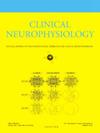失语症中内隐过程的时序:隐藏启动效应的事件相关电位研究
IF 3.6
3区 医学
Q1 CLINICAL NEUROLOGY
引用次数: 0
摘要
目的失语症中出现失语的机制尚不清楚。本研究探讨了词汇系统中自动扩散激活时间的变化可能导致失语症的观点。方法14例失语症(PWA)患者和13例对照成人完成了一个隐藏启动事件相关电位(ERP)任务。目标单词的前面是隐藏的、可见的或没有启动词,这些启动词要么立即重复,要么延迟重复。启动目标间隔是不同的。分析主要集中在N400效应上。结果spwa对即时重复和延迟重复的隐性启动都有N400的启动效应,而对照成人只对即时重复的隐性启动有N400的启动效应。此外,PWA对延迟重复的隐藏和可见启动物的启动效应相等,而对照成人对延迟重复的可见启动物的启动效应大于隐藏启动物的启动效应。结论PWA的词汇激活时间较长,内隐和外显信息整合能力较弱。提高对失语症中语言障碍的潜在机制的理解将有助于开发更有效的失语症治疗方法。本文章由计算机程序翻译,如有差异,请以英文原文为准。
Timing of implicit processes in aphasia: An event-related potential investigation of masked priming effects
Objectives
The mechanisms responsible for anomia in aphasia are not well understood. This study explores the idea that anomia could be due to changes in the timing of automatic spreading activation in the lexical system.
Methods
Fourteen people with aphasia (PWA) and 13 control adults completed a masked priming event-related potential (ERP) task. Target words were preceded by masked, visible, or no primes and were either immediate or delayed repetitions of those primes. Prime-target intervals were varied. Analyses primarily focused on N400 effects.
Results
PWA showed N400 priming effects for both immediate and delayed repetitions of masked primes, but control adults only showed priming effects for immediate repetitions of masked primes. Additionally, PWA’s priming effects were equal for delayed repetitions of masked and visible primes while the control adults showed greater priming effects for delayed repetitions of visible than masked primes.
Conclusions
Findings suggest PWA experience prolonged lexical activation and might be less able to integrate implicit and explicit information than control adults.
Significance
Improved understanding of the underlying mechanisms of language impairment in aphasia will support development of more efficient, effective aphasia treatment methods.
求助全文
通过发布文献求助,成功后即可免费获取论文全文。
去求助
来源期刊

Clinical Neurophysiology
医学-临床神经学
CiteScore
8.70
自引率
6.40%
发文量
932
审稿时长
59 days
期刊介绍:
As of January 1999, The journal Electroencephalography and Clinical Neurophysiology, and its two sections Electromyography and Motor Control and Evoked Potentials have amalgamated to become this journal - Clinical Neurophysiology.
Clinical Neurophysiology is the official journal of the International Federation of Clinical Neurophysiology, the Brazilian Society of Clinical Neurophysiology, the Czech Society of Clinical Neurophysiology, the Italian Clinical Neurophysiology Society and the International Society of Intraoperative Neurophysiology.The journal is dedicated to fostering research and disseminating information on all aspects of both normal and abnormal functioning of the nervous system. The key aim of the publication is to disseminate scholarly reports on the pathophysiology underlying diseases of the central and peripheral nervous system of human patients. Clinical trials that use neurophysiological measures to document change are encouraged, as are manuscripts reporting data on integrated neuroimaging of central nervous function including, but not limited to, functional MRI, MEG, EEG, PET and other neuroimaging modalities.
 求助内容:
求助内容: 应助结果提醒方式:
应助结果提醒方式:


